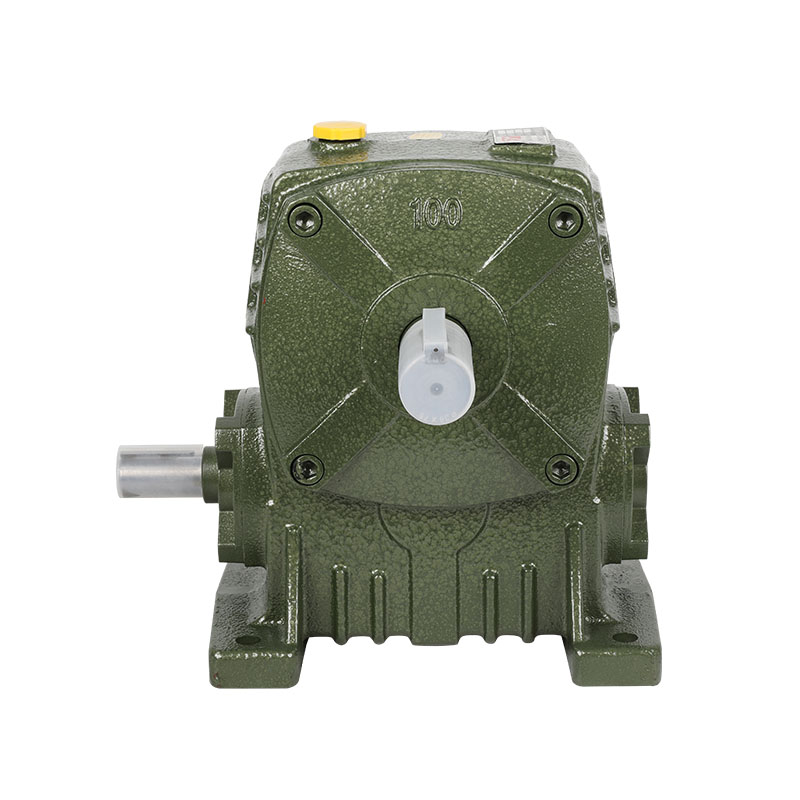To improve the overall efficiency of WP Worm Gear Reducer, especially in terms of energy saving, the selection of worm tooth shape and material plays a vital role. By optimizing the tooth profile design of the worm and using appropriate materials, friction losses during the transmission process can be significantly reduced, thereby improving efficiency. Here are several ways to improve the efficiency of your WP worm gear reducer:
The tooth shape of the worm directly affects the contact quality and friction between the worm gear and the worm, thus determining the transmission efficiency. Common worm tooth shapes have the following optimization methods:
The traditional right-angle worm tooth shape can easily lead to high friction loss due to its large contact area and uneven force. The bevel worm tooth shape can reduce friction during the meshing process and improve transmission efficiency by changing the tooth surface angle. The bevel design makes the worm tooth surface contact smoother, reduces the friction coefficient, and greatly improves efficiency.
Using improved tooth profile designs, such as involute tooth profiles or arc tooth profiles, can reduce friction between tooth surfaces during the meshing process and improve transmission efficiency. This type of design helps reduce local stress on the gear surface and improves the load-bearing capacity and wear resistance of the gear.
By increasing the contact surface of the worm tooth profile, the load pressure can be shared, local pressure concentration can be reduced, and friction losses can be reduced. Increasing the contact area can also increase the load-bearing capacity of the reducer and reduce the risk of overload.
The material selection of worms and worm gears has an important impact on friction, wear resistance and transmission efficiency. The right materials can reduce wear and maintain smooth operation, thereby increasing overall efficiency:
The commonly used worm material is high-strength alloy steel (such as 20CrMnTi). This material has good hardness and wear resistance, which can effectively reduce friction, extend service life, and improve transmission efficiency.

Surface hardening treatment (such as carburizing and nitriding treatment) of the worm material can greatly increase the surface hardness, reduce surface wear, and reduce the friction coefficient, thereby improving efficiency and durability. The treated worm surface is smoother and can reduce energy loss caused by friction.
The material of the worm gear is generally selected from softer copper alloy or cast iron materials because they can better adapt to meshing with the hard worm and provide sufficient lubrication and a small friction coefficient. Worm gears made of copper alloy materials usually have better wear resistance and lower friction coefficient, which can effectively improve overall efficiency.
In some high-efficiency reducer designs, the worm gear material can also be made of synthetic or composite materials. These materials have low friction coefficients and high wear resistance, making them suitable for energy-efficient and energy-saving applications.
Lubricating oil not only reduces friction between the worm gear and worm gear, but also acts as a cooling agent, reducing operating temperatures and preventing overheating. Proper selection of lubricating oil and regular replacement are important factors to improve the efficiency of WP worm gear reducer:
Choosing low-viscosity lubricants can reduce friction and improve transmission efficiency. Although high-viscosity lubricating oil has better lubrication effect, it may increase mechanical resistance and lead to energy loss. Therefore, it is very important to select the appropriate lubricant viscosity according to specific working conditions.
Additives (such as anti-wear agents, extreme pressure agents, etc.) can effectively reduce friction and wear on the gear surface, extend the service life of the equipment, and maintain its efficient operation.
Keeping the lubricating oil clean can reduce the wear of impurities on the gears, thereby improving transmission efficiency. Regularly replace the lubricating oil to ensure that the oil is not contaminated and can effectively maintain the efficient performance of the reducer.
The meshing angle of the worm has an important impact on transmission efficiency. Excessive meshing angle will cause greater friction and reduce efficiency. By optimizing the meshing angle of the worm, the transmission efficiency can be improved and the
Properly adjusting the meshing angle of the worm can effectively reduce friction, make gear meshing more stable, and reduce energy waste.
The number of teeth of the worm also affects the meshing angle and friction. Reasonable selection of the number of teeth of the worm can optimize the meshing surface, reduce friction and improve efficiency.
In addition to worm tooth shape and material selection, optimization of the overall design can also improve the efficiency of the WP worm gear reducer:
During the design process, ensure that the meshing clearance between the worm gears is moderate. Too large or too small a clearance will lead to reduced efficiency. Proper meshing clearance helps reduce friction and improve transmission efficiency.
The use of high-precision manufacturing processes (such as CNC machining, precision grinding, etc.) can effectively improve the meshing accuracy of worm gears, reduce gaps and friction during the meshing process, and further improve efficiency.
By optimizing the worm tooth profile design, selecting appropriate materials, controlling the meshing angle, and using efficient lubricating oil, the transmission efficiency of the WP worm gear reducer can be significantly improved, energy loss reduced, and energy saving goals achieved. In addition, improved design and precision manufacturing processes also help improve overall performance, extend service life, and reduce long-term operation and maintenance costs.

 English
English русский
русский bahasa Indonesia
bahasa Indonesia
